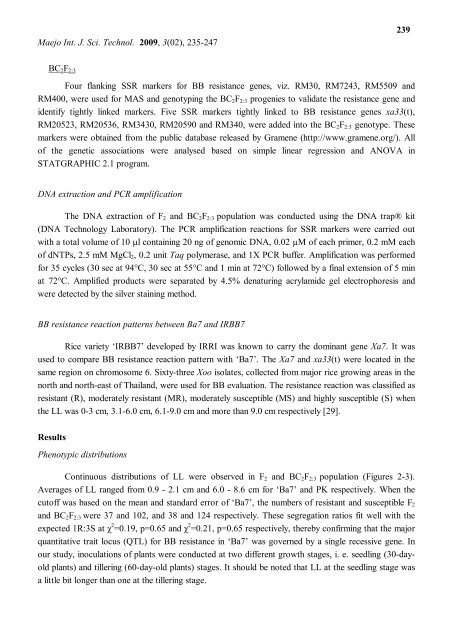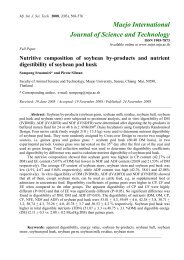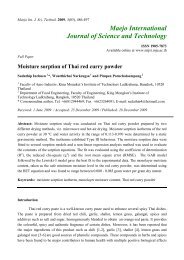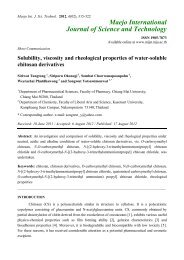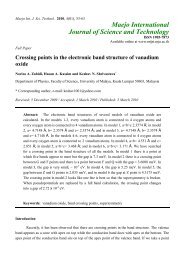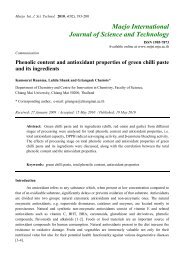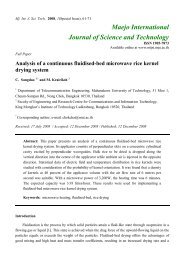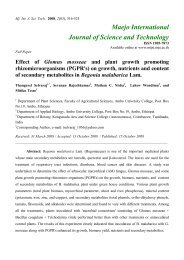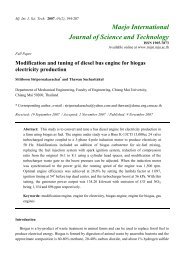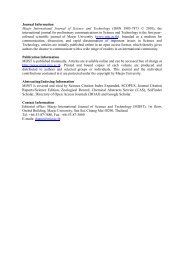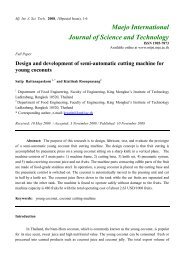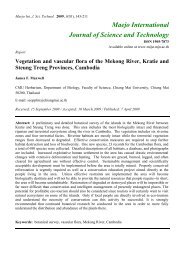(SSR) linked to a new bacterial blight resistance gene xa33 (t)
(SSR) linked to a new bacterial blight resistance gene xa33 (t)
(SSR) linked to a new bacterial blight resistance gene xa33 (t)
You also want an ePaper? Increase the reach of your titles
YUMPU automatically turns print PDFs into web optimized ePapers that Google loves.
Maejo Int. J. Sci. Technol. 2009, 3(02), 235-247239BC 2 F 2:3Four flanking <strong>SSR</strong> markers for BB <strong>resistance</strong> <strong>gene</strong>s, viz. RM30, RM7243, RM5509 andRM400, were used for MAS and genotyping the BC 2 F 2:3 progenies <strong>to</strong> validate the <strong>resistance</strong> <strong>gene</strong> andidentify tightly <strong>linked</strong> markers. Five <strong>SSR</strong> markers tightly <strong>linked</strong> <strong>to</strong> BB <strong>resistance</strong> <strong>gene</strong>s <strong>xa33</strong>(t),RM20523, RM20536, RM3430, RM20590 and RM340, were added in<strong>to</strong> the BC 2 F 2:3 genotype. Thesemarkers were obtained from the public database released by Gramene (http://www.gramene.org/). Allof the <strong>gene</strong>tic associations were analysed based on simple linear regression and ANOVA inSTATGRAPHIC 2.1 program.DNA extraction and PCR amplificationThe DNA extraction of F 2 and BC 2 F 2:3 population was conducted using the DNA trap® kit(DNA Technology Labora<strong>to</strong>ry). The PCR amplification reactions for <strong>SSR</strong> markers were carried outwith a <strong>to</strong>tal volume of 10 l containing 20 ng of genomic DNA, 0.02 µM of each primer, 0.2 mM eachof dNTPs, 2.5 mM MgCl 2 , 0.2 unit Taq polymerase, and 1X PCR buffer. Amplification was performedfor 35 cycles (30 sec at 94°C, 30 sec at 55°C and 1 min at 72°C) followed by a final extension of 5 minat 72°C. Amplified products were separated by 4.5% denaturing acrylamide gel electrophoresis andwere detected by the silver staining method.BB <strong>resistance</strong> reaction patterns between Ba7 and IRBB7Rice variety ‘IRBB7’ developed by IRRI was known <strong>to</strong> carry the dominant <strong>gene</strong> Xa7. It wasused <strong>to</strong> compare BB <strong>resistance</strong> reaction pattern with ‘Ba7’. The Xa7 and <strong>xa33</strong>(t) were located in thesame region on chromosome 6. Sixty-three Xoo isolates, collected from major rice growing areas in thenorth and north-east of Thailand, were used for BB evaluation. The <strong>resistance</strong> reaction was classified asresistant (R), moderately resistant (MR), moderately susceptible (MS) and highly susceptible (S) whenthe LL was 0-3 cm, 3.1-6.0 cm, 6.1-9.0 cm and more than 9.0 cm respectively [29].ResultsPhenotypic distributionsContinuous distributions of LL were observed in F 2 and BC 2 F 2:3 population (Figures 2-3).Averages of LL ranged from 0.9 - 2.1 cm and 6.0 - 8.6 cm for ‘Ba7’ and PK respectively. When thecu<strong>to</strong>ff was based on the mean and standard error of ‘Ba7’, the numbers of resistant and susceptible F 2and BC 2 F 2:3 were 37 and 102, and 38 and 124 respectively. These segregation ratios fit well with theexpected 1R:3S at χ 2 =0.19, p=0.65 and χ 2 =0.21, p=0.65 respectively, thereby confirming that the majorquantitative trait locus (QTL) for BB <strong>resistance</strong> in ‘Ba7’ was governed by a single recessive <strong>gene</strong>. Inour study, inoculations of plants were conducted at two different growth stages, i. e. seedling (30-dayoldplants) and tillering (60-day-old plants) stages. It should be noted that LL at the seedling stage wasa little bit longer than one at the tillering stage.


